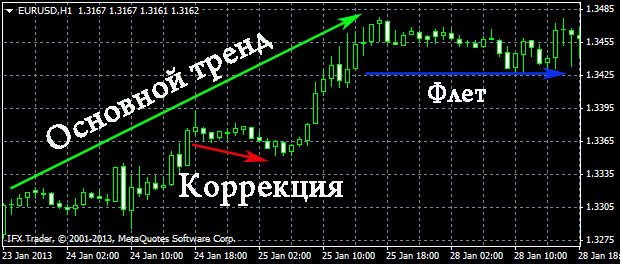What is a Forex correction and how to determine its size
As has been noted more than once, the main thing when trading forex is to determine the existing trend direction.

It should be noted that this movement does not always occur in the direction of the existing trend; in addition to the main direction, there is also a correction.
Forex correction – price rollbacks against the main direction of the trend, over a certain time period.
Such movements occur both with arbitrary regularity and relatively regularly, and their size depends primarily on the size of the timeframe. Also, correction in Forex depends on how sharp and strong the movement towards the trend was.
In practical trading, this phenomenon cannot be ignored, since it is this phenomenon that often causes premature stop loss triggering.
Even if there is an upward trend in the Forex , a short-term decrease in the price of a currency pair occurs from time to time.

This phenomenon is caused by many reasons.
Reasons for a correction in Forex
Depending on the time period you have chosen for trading, such reasons may be:
short -term changes in demand or currency demand, after a change in the situation, the price again begins to move towards the main direction.
The influence of secondary news, not every news can cause a trend turn, some of the events only cause a small rollback.
The exit from the state of overwhelming or resellibility, this usually happens after a sharp jump in the price, when the number of applications towards the trend increases to a critical mark, after the retracting and resumption of movement occurs.
Magnitude.
Surprisingly, each time period has its own magnitude of forex correction; it increases proportionally with the duration of the time frame.
The larger the timeframe , the greater the value of this indicator.
For example, on M1 the size of rollbacks can be only a couple of points, and already on D1 it can reach hundreds of points. The essence of this phenomenon lies in the specificity of displaying information in the trading terminal window, since, for example, on a minute time period you see the price behavior over an hour, and on D1 the chart window already covers several months and if the price moved against the trend even for one day, then it will still look like a Forex correction.
Therefore, if on one of the charts the fall in the exchange rate looks like a small pullback, then on the other it will be a long downward trend .
In addition, it has long been noted that the magnitude of the Forex correction is directly related to the magnitude of the movement towards the main trend.
For example, the trend movement in an hour was 200 points, followed by a rollback of 100 points, after the news was released, the trend accelerated and already exceeded 400 points, respectively, the magnitude of the correction after such a movement will be 200 points.
Meaning
When deciding whether to trade against the direction of the main trend, the correct answer will depend on which time frame you are working on. If this is M1, M5, M15, M30, then it is better to refrain from such trading and open transactions only according to the trend.
On longer time periods, you can switch to a lower timeframe and try your luck.
After strong news and a sharp jump in exchange rates, as mentioned earlier, a trend correction also occurs in Forex, and its size is almost always proportional to the trend movement. Many traders build entire strategies based on this pattern .
Another important point is that any Forex correction can turn into a trend reversal; you can check what is actually happening in the market in two ways - find out the latest news, perhaps they caused a rollback, or analyze the existing trend.
Signs of a reversal are usually a breakdown of the support or resistance line if the price begins to fall (rise) below (above) the latest lows (highs).

